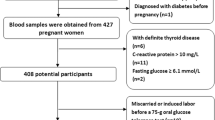Abstract
The aim of the study was to investigate the association between serum selenium levels in patients with gestational diabetes mellitus (GDM) and glucose intolerants and compare them with those of glucose-tolerant pregnant women. This cross-sectional study was prospectively performed in a total of 178 pregnant women undergoing a 50-g oral glucose tolerance test between 24 and 28 weeks of gestation who were grouped according to their status of glucose tolerance as with gestational diabetes (group A, abnormal 1- and 3-h glucose tolerance test; n = 30), glucose intolerant (group B, abnormal 1-h but normal 3-h glucose tolerance test; n = 47), or normal controls (group C, normal 1-h glucose test; n = 101). Serum selenium levels were measured with a graphite furnace atomic absorption spectrophotometer using a matrix modifier. Median maternal age and gestational age at the time of diagnosis in group A (gestational age = 24.8 [24–27]), group B (gestational age = 24.7 [24–27]), and group C (gestational age = 25 [24–28]) did not differ. Patients with gestational diabetes mellitus and those with glucose intolerants had lower selenium level than that of the normal pregnant women (P < 0.001). There was a significant inverse correlation between selenium and blood glucose level, and also selenium supplementation might prove beneficial on patients with GDM and prevent or retard them from secondary complications of diabetes.

Similar content being viewed by others
References
Kuhl C (1998) Etiology and pathogenesis of gestational diabetes. Diabetes Care 21:19–26
Kamath U, Rao G, Raghothama C, Rai L, Rao P (1998) Erythrocyte indicators of oxidative stress in gestational diabetes. Acta Paediatr 87:676–679
Bo S, Lezo A, Menato G et al (2005) Gestational hyperglycemia, zinc, selenium, and antioxidant vitamins. Nutrition 21:186–191
Holben DH, Smith AM (1999) The diverse role of selenium within selenoproteins: a review. J Am Diet Assoc 99:836–843
Hawkes WC, Alkan Z, Lang K, King JC (2004) Plasma selenium decrease during pregnancy is associated with glucose intolerance. Biol Trace Elem Res 100:19–29
Al-Saleh E, Nandakumaran M, Al-Shammari M, Al-Harouny A (2004) Maternal-fetal status of copper, iron, molybdenum, selenium and zinc in patients with gestational diabetes. J Matern Fetal Neonatal Med 16:15–21
Tan M, Sheng L, Qian Y et al (2001) Changes of serum selenium in pregnant women with gestational diabetes mellitus. Biol Trace Elem Res 83:231–237
Orhan H, Onderoglu L, Yucel A, Sahin G (2003) Circulating biomarkers of oxidative stress in complicated pregnancies. Arch Gynecol Obstet 267:189–195
Quilliot D, Dousset B, Guerci B, Dubois F, Drouin P, Ziegler O (2001) Evidence that diabetes mellitus favors impaired metabolism of zinc, copper, and selenium in chronic pancreatitis. Pancreas 22:299–306
Coustan DR, Carpenter MW (1998) The diagnosis of gestational diabetes. Diabetes Care 21:5–8
Mokdad AH, Ford ES, Bowman BA, Nelson DE, Engelgau MM, Vinicor F, Mark JS (2000) Diabetes trends in the US: 1990–1998. Diabetes Care 23:1278–1283
Kieffer EC, Carman WJ, Gillespie BW, Nolan GH, Worley SE, Guzman JR (2001) Obesity and gestational diabetes among African-American women and Latinas in Detroit: implications for disparities in women’s health. J Am Med Womens Assoc 56:181–187, 196
Ferrara A, Hedderson MM, Quesenberry CP, Selby JV (2002) Prevalence of gestational diabetes mellitus detected by the national diabetes data group or the carpenter and coustan plasma glucose thresholds. Diabetes Care 25:1625–1630
Health Canada (1999) Diabetes in Canada: national statistics and opportunities for improved surveillance, prevention and control. Public Health Agency of Canada, Canada
T.C. Sağlık Bakanlığı, Ana Çocuk Sağlığı ve Aile Planlaması Genel Müdürlüğü (2000) Ulusal Aile Planlaması Hizmet Rehberi. Cilt I, II Ankara
Felber JP, Golay A (2002) Pathways from obesity to diabetes. Int J Obes Metab Disord 26:39–45
Ihara Y, Yamada Y, Toyokuni S et al (2000) Antioxidant alpha-tocopherol ameliorates glycemic control of GK rats, a model of type 2 diabetes. FEBS Lett 473:24–26
Myatt L, Cui X (2004) Oxidative stress in the placenta. Histochem Cell Biol 122:369–382
Fainaru O, Almog B, Pinchuk I, Kupferminc MJ, Lichtenberg D, Many A (2002) Active labour is associated with increased oxidisibility of serum lipids ex vivo. BJOG 109:938–941
Mocatta TJ, Winterbourn CC, Inder TE, Darlow BA (2004) The effect of gestational age and labour on markers of lipid and protein oxidation in cord plasma. Free Radic Res 38:185–191
Wall PD, Pressman EK, Woods JR Jr (2002) Preterm premature rupture of the membranes and antioxidants: the free radical connection. J Perinat Med 30:447–457
Pressman EK, Cavanaugh JL, Mingione M, Norkus EP, Woods JR (2003) Effects of maternal antioxidant supplementation on maternal and fetal antioxidant levels: a randomized, double-blind study. Am J Obstet Gynecol 189:1720–1725
Agarwal A, Gupta S, Sharma RK (2005) Role of oxidative stress in female reproduction. Reprod Biol Endocrinol 14:3–28
Asayama K, Kooy NW, Burr IM (1986) Effect of vitamin E deficiency and selenium deficiency on insulin secretory reserve and free radical scavenging systems in islets: decrease of islet manganosuperoxide dismutase. J Lab Clin Med 107:459–464
Ezaki O (1990) The insulin like effect of selenate in rat adipocytes. J Biol Chem 265:1124–1128
Author information
Authors and Affiliations
Corresponding author
Rights and permissions
About this article
Cite this article
Kilinc, M., Guven, M.A., Ezer, M. et al. Evaluation of Serum Selenium Levels in Turkish Women with Gestational Diabetes Mellitus, Glucose Intolerants, and Normal Controls. Biol Trace Elem Res 123, 35–40 (2008). https://doi.org/10.1007/s12011-007-8087-2
Received:
Accepted:
Published:
Issue Date:
DOI: https://doi.org/10.1007/s12011-007-8087-2




